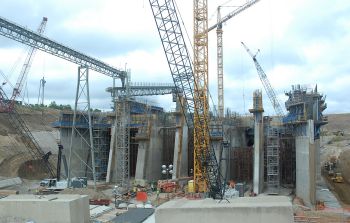Photographic Records: Difference between revisions
(Created page with "__NOTOC__ Category:Record Keeping ---- Photographic records play a crucial role in documenting the construction, maintenance, and evolution of dams. They provide a visual representation of engineering marvels and serve as valuable historical and technical references. The primary objective of photographic records in dam engineering is to document the various stages of a dam's construction and life cycle. From initial construction to ongoing maintenance an...") |
No edit summary |
||
| Line 2: | Line 2: | ||
[[Category:Record Keeping]] | [[Category:Record Keeping]] | ||
---- | ---- | ||
{{Picture | |||
<!-- Add image file name (ex.image.jpg) --> | |||
|image= Cannelton_Locks_in_progress.jpg | |||
<!--Add link if applicable --> | |||
|link= | |||
<!-- Add picture caption --> | |||
|caption=Construction in progress on Kentucky's Cannelton dam. | |||
(Image Source: [https://commons.wikimedia.org/wiki/File:Cannelton_Locks_and_Dam_hydropower_project_making_progress_(7590437174).jpg Wikimedia]) | |||
}} | |||
Photographic records play a crucial role in documenting the [[construction]], maintenance, and evolution of dams. They provide a visual representation of [[engineering]] marvels and serve as valuable historical and technical references. | Photographic records play a crucial role in documenting the [[construction]], maintenance, and evolution of dams. They provide a visual representation of [[engineering]] marvels and serve as valuable historical and technical references. | ||
Revision as of 17:36, 19 July 2023

|
| Construction in progress on Kentucky's Cannelton dam.
(Image Source: Wikimedia) |
Photographic records play a crucial role in documenting the construction, maintenance, and evolution of dams. They provide a visual representation of engineering marvels and serve as valuable historical and technical references.
The primary objective of photographic records in dam engineering is to document the various stages of a dam's construction and life cycle. From initial construction to ongoing maintenance and potential modifications, photographs capture the progress of the dam project. These records serve as a visual documentation of the design, construction techniques, and engineering solutions employed, providing a comprehensive reference for future analysis, assessment, and decision-making.
Photographic records offer several benefits in the field of dam engineering. Firstly, they serve as a historical archive, preserving the visual history of dams for future generations. These records capture significant milestones, events, and changes in the dam's physical attributes, allowing engineers, historians, and researchers to study and understand the evolution of dam technology over time. Secondly, photographic records allow engineers to compare the current condition of a dam with its original construction or earlier maintenance phases, providing a valuable resource for inspections and assessments.
Photographic records provide technical documentation of dams, capturing critical details and dimensions that may be difficult to obtain through other means. High-resolution photographs can capture intricate features, construction techniques, and structural elements, enabling engineers to conduct visual assessments and analyze the performance of various components. The records also help in monitoring and evaluating potential changes in the dam's condition, such as cracks, settlement, or erosion, over extended periods of time.
Photographic records allow engineers to make informed decisions and collaborate effectively with dam engineers, operators, and stakeholders. These visual records can be used to present the progress, challenges, and achievements of dam projects, aiding in project reviews, public consultations, and regulatory compliance. The photographs provide a clear and easily understandable representation of complex engineering concepts, enabling effective communication and collaboration among multidisciplinary teams involved in dam management.
These records also play a vital role in preserving the legacy of dams as significant engineering achievements. By capturing the construction, operation, and maintenance phases, these records contribute to the collective knowledge and understanding of dam engineering. They provide a link between the past and present, allowing future generations to appreciate the ingenuity, effort, and impact of these structures on society, water resource management, and sustainable development. Moreover, the preservation of photographic records ensures that valuable lessons learned from past dam projects can be applied to future endeavors.
